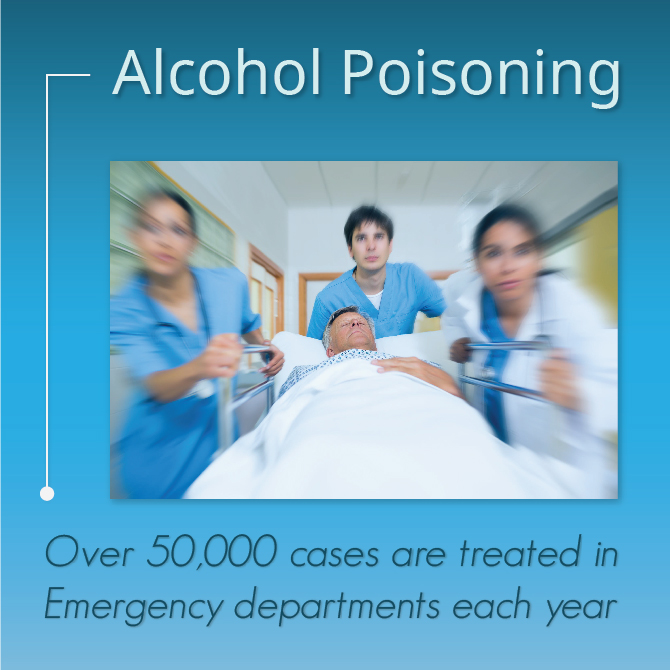What Is Alcohol Poisoning?
Alcohol poisoning can occur with any type of alcohol consumption. It refers to enough of an intake of alcohol to overwhelm the body’s ability to process it. Ethanol or ethyl alcohol is what we buy at bars, restaurants, liquor stores and supermarkets. Unfortunately, many members of the public mistake this term for the illness that results from consuming other types of alcohols, such as rubbing alcohol, antifreeze and paint removers. While some individuals do consume these other alcohol types to result in severe injury and illness, the vast majority of alcohol poisoning cases occur with the regular ethanol routinely consumed. Over 50,000 cases are treated in emergency departments each year and many, many more are “treated” at home.
How It Starts
Ethyl alcohol poisoning is the result of consuming more alcohol than your liver is capable of metabolizing. Although alcohol metabolism rates vary widely according to an individual’s size, gender, tolerance and the concentration of alcohol ingested, the general rule of thumb is that the liver can metabolize one standard alcohol drink per hour. If an individual consumes more than one drink in an hour, his blood alcohol level begins to rise. When binge drinking, multiple drinks are ingested during this hour, the drinker’s blood alcohol level can quickly reach and exceed 0.08 mg/dL, the legal limit that presumes intoxication in most states.
Side effects of even small amounts of alcohol include impaired judgment and poor impulse control. This is especially true when an individual’s blood alcohol level is at or above the legal limit of 0.08 mg/dL. It may appear perfectly reasonable for an already-intoxicated drinker to have more to drink or increase their rate of ingestion.
How to Treat Alcohol Poisoning
Alcohol poisoning is treated with necessary measures to support life, almost always within an emergency department situation. The patient is given sugar water intravenously to offset alcohol’s dehydrating effects and avoid an abrupt blood sugar drop once the alcohol intake has ceased. Oxygen is administered by nasal canal to ensure adequate oxygenation to the brain and body tissues, despite depressed breathing from the alcohol toxicity’s effect on the brain’s respiratory center. Thiamine and B-vitamins are administered in the intravenous fluids to replace those lost during the binge’s dehydration’s effects and avoid neurological damage. Finally, the patient is monitored to ensure that they do not stop breathing or begin vomiting which may choke them. For lucky patients, emergency treatment can result in a referral to an inpatient treatment facility.
Patients cannot be released from an emergency department or transferred to an alcohol rehab center until their condition is stabilized, their blood alcohol levels have decreased, they know where and who they are, and they are generally “sobering up.” For patients transferred to a alcohol rehab center, they will begin to treatment with benzodiazepine medications such as Valium, Klonopin or Xanax to avoid the development of delirium tremors or DT’s as the alcohol is removed from their systems. They are allowed to rest and rehydrate themselves with water and juices and begin eating food again. After a day or two, they will be expected to begin classes in addiction, alcoholism and group therapy. Inpatient alcohol rehabilitation may be as short as 30 days or as long as a 9 months, depending upon the patient’s insurance and financial situation. Throughout all of inpatient treatment, plans will be laid for outpatient therapy and support groups to help maintain sobriety.
Let Drugrehab.org Help Today
 You are not alone in your struggle, and there is hope. Please contact Drugrehab.org today and get help. Don’t wait a day longer in the depths of an addiction. Alcohol poisoning is a real problem today. Drugrehab.org can help you or someone you care for gain control of life again.
You are not alone in your struggle, and there is hope. Please contact Drugrehab.org today and get help. Don’t wait a day longer in the depths of an addiction. Alcohol poisoning is a real problem today. Drugrehab.org can help you or someone you care for gain control of life again.
Call us today at the toll free number at the top of the page. If emailing us is more convenient, please fill out our form in the right column. Take your first and most important step toward recovery.


